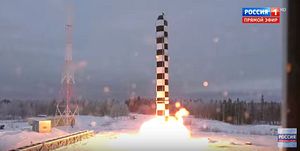A new hypersonic glide vehicle (HGV)—the Avangard (Vanguard in English) hypersonic boost-glide warhead—is expected to enter service with Russia’s Strategic Missile Force no later than 2019, according to a Russian defense industry source.
“After the first series of glide vehicles is produced and a controlling launch of a missile with this armament is carried out successfully, the Avangard complex may be accepted for service already in late 2018. At the latest, it will be accepted for operation and placed on high alert in 2019,” the source told TASS news agency on March 15.
Russian President Vladimir Putin announced during his annual State of the Union address on March 1 that the Avangard HGV, developed under the secret Project 4202 and codenamed Yu-71, has already entered serial production. “I can tell you that we have all this already and it works well. Moreover, Russia’s industry has begun to batch-produce this system. It is yet another type of strategic weapon at Russia’s disposal,” Putin said. “We’ve called it Avangard.”
The HGV is capable of traveling at speeds greater than Mach 20, according to the Russian president. Additionally, Putin explained:
New composite materials have allowed for coping with the problem of keeping the winged vehicle under control during a prolonged flight amid plasma. In fact, while approaching the target it looks like a meteorite. A fireball. The temperature on its surface may reach 1,600-2,000 Celsius. Control of the winged vehicle remains reliable all the way.
The Russian Ministry of Defense has purportedly already signed a contract for the first batch of Avangard HGVs, while the commander of Russia’s Strategic Missile Force, General Sergei Karakayev, said the trials of the new weapon system has been completed.
Given the complexity and technical difficulties that go into designing a hypersonic warhead, the 2019 induction date appears to be unrealistic at this juncture and there has been no official confirmation by the Russian MoD that the Avangard will enter service by 2019. Furthermore, the U.S. intelligence community noted in 2017 that China’s HGV warhead, the DF-17, will be the first to see operational deployment anywhere, implicitly suggesting that the Avangard will probably not make the 2019 deployment.
The Avangard HGV will likely be mounted on Russia’s newest and most powerful intercontinental ballistic missile (ICBM), the RS-28 Sarmat (NATO designation: SS-X-29 Satan 2). The Sarmat can be fitted with more than ten nuclear warheads. However, three to five HGVs per missile seem more realistic. The missile is expected to enter service by 2020, replacing the Soviet-era RS-36M Voyevod ICBMs. However, as with the majority of Russian defense programs, the project has encountered multiple delays and it appears unlikely that the Sarmat will enter service within the next two years.
As I reported last week, preparations are underway for another set of tests of the missile at the Plesetsk space center.
































